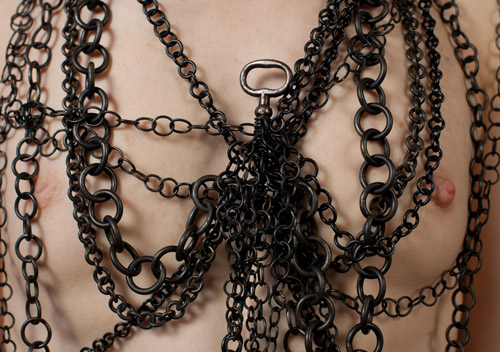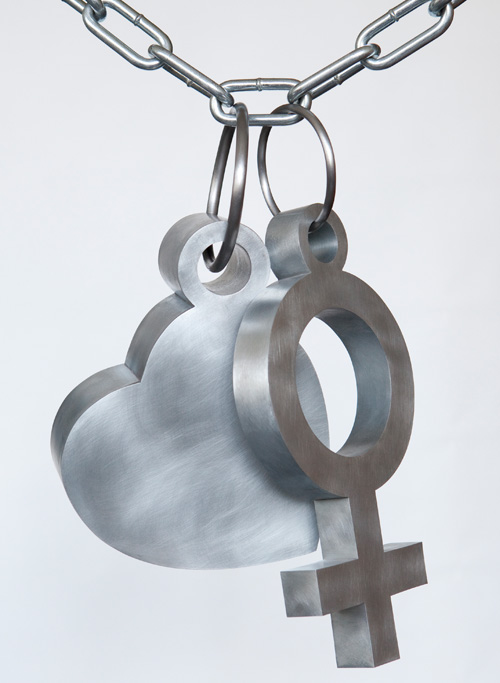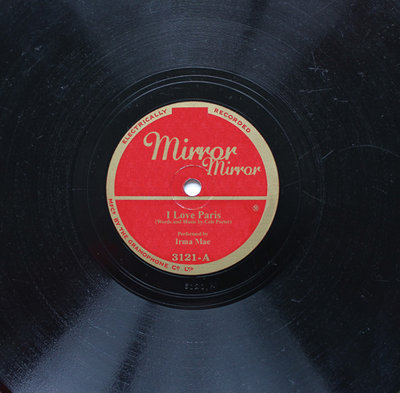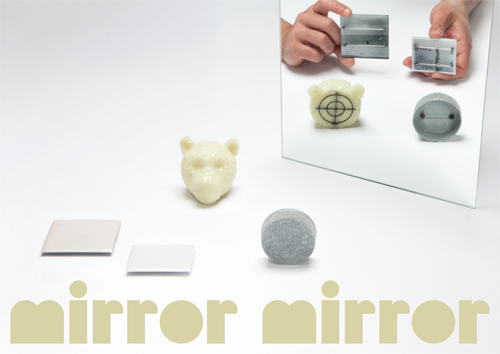
The international team of Jo Bloxham from England and Ben Lignel from France (our new editor) curated this exhibition, and Velvet da Vinci is its only US venue. Gallery owners Mike Holmes and Elizabeth Shypertt have a large and active international network from which to draw this type of show. Lucky for those of us who live near them! A beautifully designed catalog is available from the gallery.
Susan Cummins: First, please explain your background and in particular your interest in contemporary jewelry.
Jo Bloxham: I was initially a maker until I accidentally fell into curating during my masters degree. I curated an exhibition called Romancing the Stone, which became the main submission for my MA. I soon realized I was better at curating than I was at making, so decided to put my toolbox away and concentrate on producing themed exhibitions on an international scale. Curating involves lots of dialogue with like-minded people, which suits me better than sitting alone in a studio with my cats for company.
I am also an avid collector, so jewelry is a big part of my life.

Jo Bloxham: The idea was born during one of many visits to Espace Solidor in Cagnes-sur-Mer in the South of France. Espace Solidor is a publicly owned gallery dedicated to contemporary jewelry. It is perched on a hill in the middle of a beautiful medieval village. The gallery is named after Suzy Solidor, who lived in Cagnes-sur-Mer until her death in 1983. She was a renowned figure in the Parisian nightlife of the 1930s. Chateau Grimaldi, which is near Cagnes-sur-Mer, has a room dedicated to Suzy with her collection of portraits of herself on permanent display. It became clear that she had been an iconic figure in the town, so why not make an exhibition about the life of the woman for whom the gallery is named?
At what point did you and Ben Lignel, the French maker and new AJF editor, decide to co-curate?
Jo Bloxham: We decided to team up very early on in the project. We liked the idea of curating something together, and as Ben’s spoken French is somewhat more advanced than mine, this seemed like the perfect opportunity. As it happened, Ben was the main driver behind this project and brought it together seamlessly.
Why was Suzy Solidor such an intriguing figure to you?
Jo Bloxham: Suzy was an enigma. None of the artists we invited to take part in the exhibition had heard of her, so we were pleasantly surprised when all the invitees accepted the invitation. Suzy was openly bisexual and lived her life in public view. She was famous for being infamous, and the many portraits of her showed many aspects of her persona. She posed for many well-known artists, who she commissioned to paint her portrait as a means of feeding her enormous ego.

What instructions did you send the artists? How much information did you supply about Suzy Solidor?
Jo Bloxham: We sent some images of Suzy as well as biography of her life, focusing on her sexuality and her rebellious nature. All of the artists were asked to do their own research, choose an aspect of her life that they found interesting, and use that as a starting point. There were few restrictions from our side. It was important to give the artists involved the creative freedom needed to produce new work.

Jo Bloxham: Most of the pieces were a surprise, which is one of the joys of curating. Liesbet Bussche produced an enormous charm bracelet that was displayed across the street, replacing a chain used to keep the traffic out of the village square. She found the chain barrier by using Google maps street view and was able to make the piece fit perfectly without ever having visited the town.
Mah Rana did not actually make jewelry Mirror Mirror. Instead, she transformed herself into a 1930s nightclub singer called Miss Irma Mae who, after nine months of singing lessons, cut a record for the show. She also performed live at the opening of the exhibition. It never ceases to amaze me how much thought and energy the artists put into these pieces!
I was interested in the fact that some of the pieces weren’t jewelry at all—Mah Rana sent a recording in the form of an old style vinyl record, and Nanna Melland sent a video along with her chain and key. In general, have you seen evidence of jewelers incorporating other media into their work?
Jo Bloxham: A concept or an idea may not always be possible to achieve through a wearable piece of jewelry. Sometimes, it may need to be realized through an object, installation, or piece of film. An example is Lauren Kalman’s film Certainly Red, which is a comment about the pressure women may feel to be beautiful. I do feel that an exhibition becomes more exciting with the inclusion of an extra element of surprise.

Jo Bloxham: The catalog was entirely Ben’s idea. He had a very strong vision of how he wanted to present it. The visual inclusion of the packing material and the boxes gives the viewer a glimpse of what it is like to curate an exhibition and the excitement one feels when opening a box and not knowing what you will find inside. The catalog is an integral part of Mirror Mirror. It was designed to be an additional exhibit in the show rather than a documentation of it. It is a beautiful publication that will live on long after the exhibition closes.
Mirror Mirror was shown in France for two months during the summer. It then travelled to Velvet da Vinci where it will be shown for the last time.
Ben and I are very grateful to the town of Cagnes-sur-Mer for agreeing to support this project, and to Velvet da Vinci for showing it ‘across the pond.’
Thank you.





